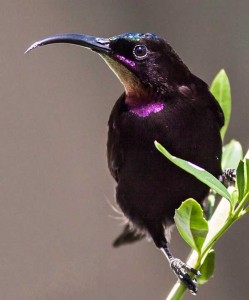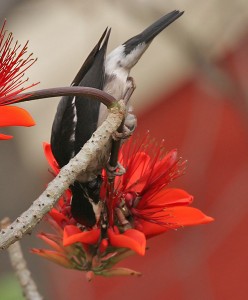In order to maintain sufficient energy levels, it is necessary for animals to acquire food in effective and efficient ways. For nectarivorous birds, this means being able to obtain enough energy through feeding to balance and surpass the energy expended through foraging. The ability to identify and return to rewarding nectar sites is advantageous for nectarivores trying to meet the high energy demands of their lifestyle, and this ability requires some amount of recognition of flowers that may be more nutritionally dense than others. Previous research has demonstrated that experiential learning is a common method throughout the animal kingdom for increasing feeding efficiency, with different animals relying on the presence of different cues, including visual, auditory, and olfactory stimuli.
To investigate the use of cue recognition in nomadic, nectarivorous sunbirds, Whitfield et al. tested the ability of amethyst sunbirds to recognize, recall, and utilize different color cues as indicators of nectar quality. In addition, the researchers examined whether feeding selectivity, if observed, would contribute to higher overall foraging efficiency. To do this, the birds were presented with an arrangement of feeders, with most containing a low concentration of sucrose, and some containing a higher concentration, which sunbirds show a preference for. The birds were allowed to forage prior to training, with no color cues. The birds were then trained with visual cues to recognize one color as being associated with the higher concentration, and another to indicate the lower. The birds were tested with color cues the day after feeding, without the colors for five days, and then with the colors again on the seventh day. All experiments were performed in a seminatural aviary setting.

The amethyst sunbird. http://www.wildlife-pictures-online.com/amethyst-sunbird-3325.html
The results showed that the birds foraged randomly in their first, non-trained trial, with the percent of birds visiting the high concentration feeders first was 27%, no higher than expected. After training and addition of color cues, and rearrangement of feeders to prevent bias from spatial recognition, the birds initially visited the nectar rich feeders 63% of the time, almost twice as much as would be expected for random selection. The trial that was given 7 days after training yielded similar results, with the proportion of first visits to rich feeders at 75%. The birds obtained significantly higher levels of energy from the rich feeders during trials with color cues than without. Additionally, the birds fed significantly less often and for a shorter amount of time with color cues, and had significantly higher rate of energy gain per meal in the presence of color cues.

Nectarivores often prefer brightly colored flowers, such as red or orange. http://en.wikipedia.org/wiki/Erythrina
The findings of this experiment indicate that amethyst sunbirds are in fact capable of learning to associate visual color cues with preferable food sources, without using spatial cues. However, in the field, it is probable that using spatial memory is a very important technique for foraging and is used in conjunction with color cues. The tendency of the birds to feed for less time and less often when using color cues supports the idea of experiential learning as an adaptive strategy, as obtaining more energy while spending less time foraging allows for the time and energy to be expended elsewhere, such as towards reproduction or territory defense. Additionally, it is of importance to note that the birds were able to recall the meaning of the color cues even almost a week after training. This is suggestive of a longer-term memory ability, which could be incredible useful for birds revisiting foraging sites at different times. Though it is difficult to know what the significance of these results might be in a natural foraging setting, this study provides strong evidence of associative learning of color cues as a foraging adaptation in the amethyst sunbird.
Whitfield, M., Köhler, A., Nicholson, S. W. (2014) Sunbirds increase foraging success by using color as a cue for nectar quality. Behavioral Ecology (25)2 328-334.
